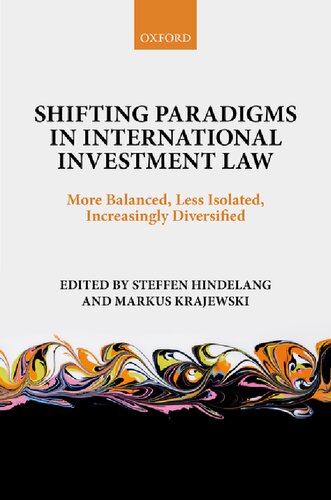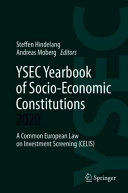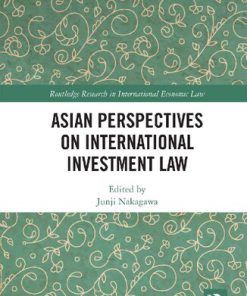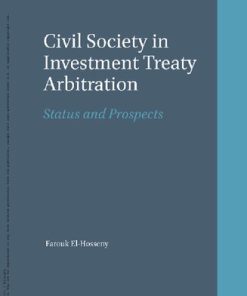Shifting Paradigms in International Investment Law More Balanced Less Isolated Increasingly Diversified 1st Edition by Steffen Hindelang, Markus Krajewski 9780191058295 0191058297
$50.00 Original price was: $50.00.$25.00Current price is: $25.00.
Shifting Paradigms in International Investment Law More Balanced Less Isolated Increasingly Diversified 1st Edition by Steffen Hindelang, Markus Krajewski – Ebook PDF Instant Download/Delivery: 9780191058295, 0191058297
Full download Shifting Paradigms in International Investment Law More Balanced Less Isolated Increasingly Diversified 1st Edition after payment

Product details:
• ISBN 10:0191058297
• ISBN 13:9780191058295
• Author:Steffen Hindelang, Markus Krajewski
Shifting Paradigms in International Investment Law
More Balanced, Less Isolated, Increasingly Diversified
International investment law is in transition. Whereas the prevailing mindset has always been the protection of the economic interests of individual investors, new developments in international investment law have brought about a paradigm shift. There is now more than ever before an interest in a more inclusive, transparent, and public regime. Shifting Paradigms in International Investment Law addresses these changes against the background of the UNCTAD framework to reform investment treaties. The book analyses how the investment treaty regime has changed and how it ought to be changing to reconcile private property interests and the state’s duty to regulate in the public interest. In doing so, the volume tracks attempts in international investment law to recalibrate itself towards a more balanced, less isolated, and increasingly diversified regime. The individual chapters of this edited volume address the contents of investment agreements, the system of dispute settlement, the interrelation of investment agreements with other areas of public international law, constitutional questions, and new regional perspectives from Europe, South Africa, the Pacific Rim Region, and Latin America. Together they provide an invaluable resource for scholars, practitioners, and policymakers. The individual chapters of this edited volume address the contents of investment agreements, the system of dispute settlement, the interrelation of investment agreements with other areas of public international law, constitutional questions, and new regional perspectives from Europe, South Africa, the Pacific Rim Region, and Latin America. Together they provide an invaluable resource for scholars, practitioners, and policymakers.
Shifting Paradigms in International Investment Law More Balanced Less Isolated Increasingly Diversified 1st Table of contents:
Towards a More Comprehensive Approach in International Investment Law
I. Investment Protection and Sustainable Development: Key Issues
I. Introduction: The Role of Foreign Direct Investment in Promoting Development
II. The Concept of ‘Sustainable Development’: Economic Background
III. Content and Legal Definitions of ‘Sustainable Development’
IV. Foreign Investment: International Protection and Regulation
V. The Evolution of BITs: From Just Protecting Investors to Safeguarding also the Rights of Host States to pursue their General Interest
VI. The International Protection of Foreign Investment and Sustainable Development: Interference and Support
II. Negotiating New Generation International Investment Agreements: New Sustainable Development Oriented Initiatives
I. Introduction
II. Sustainable Development and IIA Reform
III. Treaty Design and Sustainable Development
a) Preamble
b) Pre-establishment rights
IV. Resolving Controversial Interpretations of Existing Provisions
a) Fair and equitable treatment (FET)
b) Regulatory takings
c) Most-favoured-nation (MFN) treatment
d) National treatment
e) Scope and definition
V. The Inclusion of New Sustainable Development Oriented Provisions
a) General exceptions
b) Investor responsibilities
c) State obligations and institutional structures
d) Special and differential treatment provisions
e) Sustainability assessment
VI. Reform of Investor-State Dispute Settlement
VII. Concluding Remarks
III. Revising Treatment Standards—Fair and Equitable Treatment in Light of Sustainable Development
I. Introduction
II. What is Fair and Equitable Treatment and What are the Problems?
III. Policy Options in the IPFSD
a) Unqualified commitment of fair and equitable treatment
b) Reference to international law/minimum standard
c) Exhaustive list of fair and equitable treatment obligations
d) Interpretative guidance to arbitral tribunals
e) Omit fair and equitable treatment clause
IV. Conclusion
IV. Expropriation in the Light of the UNCTAD Investment Policy Framework for Sustainable Development
I. Introduction
II. The Role of Sustainable Development in the Context of Expropriation
a) Pre-modern (indirect) expropriation clauses
aa) The sole effects doctrine
bb) The police powers doctrine
b) Modern expropriation clauses
III. Conclusion
V. Investment Arbitration: Learning from Experience
I. Introduction
II. ISDS and Sustainable Development
III. Should there be Adjudication of Investment Disputes?
IV. Is Arbitration Ill Suited for Investment Disputes?
V. The Need for Transparency and Public Participation
VI. The Need for an Appellate Body?
VII. A Reintroduction of the Local Remedies Rule?
VIII. Conclusion
VI. The European Commission and UNCTAD Reform Agendas: Do They Ensure Independence, Openness, and Fairness in Investor–State Arbitration?
I. Introduction
II. The Approaches to Reform
III. Independence and Impartiality
IV. Openness
V. Procedural Fairness
VI. Conclusion
VII. Sustainable Development Provisions in International Trade Treaties: What Lessons for International Investment Agreements?
I. Introduction
II. Sustainable Development
III. Survey of Sustainable Development Provisions in International Trade and Investment Treaties Related to Labour Standards and the Environment
a) A taxonomy of sustainable development provisions—focusing on environmental protection and labour rights
b) Environmental and labour rights protection provisions in PTIAs and BITs
IV. Summary of Survey of Labour Rights and Environmental Protection Provisions in PTIAs and BITs
V. Factors Affecting the Likelihood that PTIA Provisions Regarding Labour Rights and Environmental Protection will be Adopted in BITs
a) Introduction
b) Factors encouraging the adoption of labour rights and environmental protection provisions in BITs
c) Factors discouraging the adoption of labour rights and environmental protection provisions in BITs
VI. Conclusion
VIII. Reconciling Investment Protection and Sustainable Development: A Plea for an Interpretative U-Turn
I. Introduction
II. The Vienna Rules as a Gateway for Sustainable Development
a) Applicability of the Vienna rules
b) Meaning and legal status of sustainable development
c) The Vienna rules’ potential to reconcile investment protection and sustainable development concerns
aa) Interpretation and conflicts of norms
bb) The Vienna rules and international investment agreements
III. Putting Theory into Practice: A Critical Review of Arbitral Jurisprudence
a) No single combined operation for sustainable development
b) Inadequate consideration of contextual arguments
c) The prominent role of de facto precedents
IV. Conclusion
IX. Investment Protection and Sustainable Development: What Role for the Law of State Responsibility?
I. Remedies and Regulatory Space: The UNCTAD Suggestions for Sustainable Development
II. Legal Consequences in General International Law
III. Legal Consequences of Treaty Breaches in International Investment Law
a) Applicability of the ASR remedies
b) The choice between restitution and compensation in the practice of investment arbitration
c) Analysis
IV. Rethinking the Role of State Responsibility in the Context of Investment Protection and Sustainable Development
a) Restitution—an undue infringement of State sovereignty?
b) State responsibility as a set of secondary rules
c) State sovereignty and the development of international law
V. Conclusion
X. Termination and Renegotiation of International Investment Agreements
I. Introduction
II. Reasons for the Current Importance of Termination and Renegotiation of Investment Agreements
a) Current shift from ‘second generation’ to ‘third generation’ investment agreements
b) The rise of regionalism in international investment treaty-making
III. ‘Termination without Renegotiation’: Legal Issues Arising from the Denunciation of Investment Agreements
a) Investment treaty provisions stipulating requirements of a lawful termination
b) ‘Survival clauses’: treaty provisions addressing the consequences arising from denunciations
IV. ‘Termination as a Result of Renegotiation’: Normative Implications of Investment Treaty Termination by Mutual Consent
a) Mutually agreed terminations in accordance with the relevant treaty provisions
b) Terminations by mutual consent in disregard of applicable treaty provisions
aa) Doctrinal and practical relevance
bb) A closer look at Article 54 (b) VCLT and its normative limitations
cc) ‘Starting all over again’: on the past and present scope of application of termination clauses
V. ‘Renegotiation without (simultaneous) Termination’: Treaty Amendments and Suspensions in Light of Termination Clauses
a) ‘Ordinary’ treaty amendments and authoritative interpretations
b) Treaty practice aimed at ‘circumventing’ termination clauses
VI. Conclusion
XI. The Emergence of a New Approach to Investment Protection in South Africa
I. Introduction
II. South Africa and BITs
III. South Africa Faces International Investment Arbitration under its BITs
IV. South Africa Reviews its BIT Policy Framework
a) The main findings of the Review
b) The 2010 Cabinet Decision
V. The Emergence of a New Approach to Investment Protection in South Africa
VI. The Draft Promotion and Protection of Investment Bill
a) Interpretation
b) Security of investment
c) Expropriation
d) Dispute settlement
e) Sovereign right to regulate in the public interest
VII. A South African Model BIT
VIII. A Dual Investment Protection Regime?
IX. Conclusion
a) Balancing investment protection and sustainable development in South Africa
b) What does replacing BITs with the PPI Bill mean?
c) A dual approach to investment protection
d) South Africa and the shifting paradigm in international investment law
XII. Reliance on Alternative Methods for Investment Protection through National Laws, Investment Contracts, and Regional Institutions in Latin America
I. Introduction
II. Recent Developments in Investment Treaty and Contractual Practice in Latin America
III. Investment Contracts and National Laws as Legal Means for the Protection and Regulation of Foreign Investment in Latin America
a) Investment laws and dispute settlement through arbitration
b) Stabilization clauses
c) Addressing non-economic concerns
d) The future of IIAs
IV. Regional Initiatives in Latin America for Challenging the Status Quo of ISDS
a) The UNASUR Centre for the Settlement of Investment Disputes
aa) Background
bb) Structure and basic principles
cc) Potential scope of jurisdiction
dd) Relationship between inter-State and investor–state disputes
ee) Outlook
b) Observatory on Transnational Corporations
V. Conclusion
XIII. Jumping Back and Forth between Domestic Courts and ISDS: Mixed Signals from the Asia-Pacific Region
I. Introduction
II. The Practical Value of ISDS
III. Domestic Policies—Australia and the Asia Pacific
a) Australian Labor Party’s 2011 trade policy
b) The Coalition Government’s current policy
c) Australia’s regional investment interests
d) Australia not alone—Indonesia’s apparent aversion to ISDS
e) Regional concerns—the Trans-Pacific Partnership Agreement
IV. ISDS or Domestic Courts
V. The Future of ISDS for Australia
VI. Conclusion
XIV. The ‘Generalization’ of International Investment Law in Constitutional Perspective
I. Introduction
II. From Splendid Isolation to Centre Stage
a) Splendid isolation and reform
b) Interlinkages to other areas of international economic law and general international law
c) Recent experiences of the application of international investment law
d) Generalization: CETA, TTIP, and others
III. A ‘Constitutional’ View
IV. Aspects of Sovereignty, Democracy, and Legitimation
V. Review of the Exercise of Public Authority— by an Arbitral Body?
a) The Autonomy of the EU Legal Order
b) The Arbitration Procedure
VI. A Fast Track to Compensation?
VII. ‘Reverse discrimination’ as an Aspect of Non-discrimination
VIII. International Constitutional Dimensions
a) Investors’ rights as a substitute for a human right to property—or the other way round?
b) A proper role for the individual in an international economic law for the global marketplace
IX. Outlook
XV. The Contribution of EU Trade Agreements to the Development of International Investment Law
I. Introduction
II. The Concept of Sustainable Development in EU Agreements
a) Definition of sustainable development
aa) UNCTAD Report 2012
bb) The Brussels Consensus
b) The EU sustainable development chapter
aa) Free Trade Agreements (FTAs)
bb) Investment Protection Agreements
c) Further EU reforms
aa) Fair and equitable treatment
bb) Expropriation
III. Importance of International Law
IV. Enforcement
a) Mediation
b) Domestic Remedies
c) Improved Enforcement Mechanism
V. Conclusion
Conclusion and Outlook: Whither International Investment Law?
I. Where Do We Stand?
a) More balanced
b) More diversified
c) Less isolated?
II. Where Do We Go from Here?
a) The protection of the State’s ability to regulate
b) Reform of the dispute settlement system
c) Relationship between investment protection and domestic legal remedies
Bibliography
Index
People also search for Shifting Paradigms in International Investment Law More Balanced Less Isolated Increasingly Diversified 1st:
shifting paradigms in international
shifting paradigms in international investment law
shifting paradigms meaning
shifting paradigms
what is paradigm in international relations
You may also like…
Education Studies & Teaching - School Education & Teaching
Jurisprudence & Law - Foreign & International Law
Jurisprudence & Law - Foreign & International Law
Jurisprudence & Law - Foreign & International Law
Private Actors in International Investment Law 1st Edition Katia Fach Gómez
Business & Economics
Uncategorized
Uncategorized











